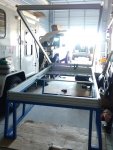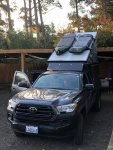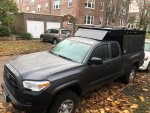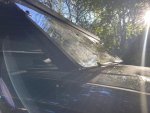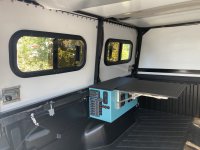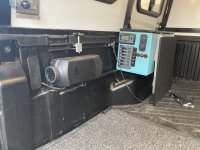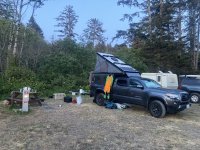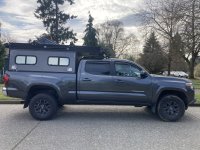Surftransplant
Member
The next steps were the mounting of the gas struts to the pop up roof and designing and building of the tent. This part I planned to do more on the fly because I knew I needed the final dimensions and it would be easiest to build this with the camper parked right next to the workshop. I was lucky to have access to the Doyle Sailmakers Loft in Alameda, I had worked there for 3 years a while ago now and Bill was very cool with me working on something there while I wouldn't be in the way. The gas struts were 125 lb, 38", with 15" stroke from Guden. I was really impressed with the hardware and ease of install. I used 5/16" 18 t nuts tomount the strut mounting plates to the extruded frame. My process was to prop the top of the camper up (with adjustable crutches) until I got it to the desired height, then mount the gas struts, tension the mounts, and see where the top came back after we dropped it and pushed it back up.
The tent is made from vinyl coated polyester with water-resistant zippers. The bottom panels of the windows have fiberglass battens sewn into them. This makes them much easier to roll up but can sometimes get in the way while trying to pack down the tent to close the camper.
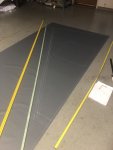


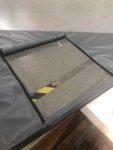
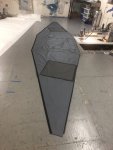
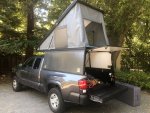
I did all of this by measuring dimensions of the camper. At one point I questioned how perfect the tent would be and added .25" to the width and height of the center panel just in case the tent ended up too small to ensure it would be installable with that tolerance. After remeasuring after the build, it looks like the tent is exactly .25" too wide and tall on that panel which makes it harder to tension up. Overall it still looks good, but I think it would be easy to improve. I ran out of time to add additional vents beyond the window. I got the tent designed and built in 2 days over the weekend and ended up spending 33 hours on that. That probably took longer because I hadn't built any sails in 6 years, and was a bit rusty. Still really enjoyed the process. The bug screens are no-see-um mesh from seattle fabrics, which is where I bought all of these materials.
The back window does not have a bug screen. Bug screens were really time consuming to make, because adhesives didn't stick to them well and they were difficult to tension. I ran out of time and wanted to keep at least one window an unobstructed view window.
After finishing the roof and driving the camper down to CA without a fairing, I realized I probably really needed a fairing and did some quick research into low cost solutions while I was down there. I decided to use a 1/4" UV stabilized polycarbonate panel cut to size at tap plastics, some stock 45 degree brackets from McMaster Car, some rubber 1/16" gasket material, and stainless steel bolts and nylocks.
I'm really happy that up to around 55-60 mph the truck still gets over 20 mpg with the camper. The faster I go above that it starts to drop but doesn't go much under 18 mpg with the fairing which is a BIG improvement.

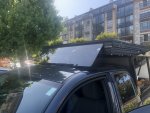

The tent is made from vinyl coated polyester with water-resistant zippers. The bottom panels of the windows have fiberglass battens sewn into them. This makes them much easier to roll up but can sometimes get in the way while trying to pack down the tent to close the camper.






I did all of this by measuring dimensions of the camper. At one point I questioned how perfect the tent would be and added .25" to the width and height of the center panel just in case the tent ended up too small to ensure it would be installable with that tolerance. After remeasuring after the build, it looks like the tent is exactly .25" too wide and tall on that panel which makes it harder to tension up. Overall it still looks good, but I think it would be easy to improve. I ran out of time to add additional vents beyond the window. I got the tent designed and built in 2 days over the weekend and ended up spending 33 hours on that. That probably took longer because I hadn't built any sails in 6 years, and was a bit rusty. Still really enjoyed the process. The bug screens are no-see-um mesh from seattle fabrics, which is where I bought all of these materials.
The back window does not have a bug screen. Bug screens were really time consuming to make, because adhesives didn't stick to them well and they were difficult to tension. I ran out of time and wanted to keep at least one window an unobstructed view window.
After finishing the roof and driving the camper down to CA without a fairing, I realized I probably really needed a fairing and did some quick research into low cost solutions while I was down there. I decided to use a 1/4" UV stabilized polycarbonate panel cut to size at tap plastics, some stock 45 degree brackets from McMaster Car, some rubber 1/16" gasket material, and stainless steel bolts and nylocks.
I'm really happy that up to around 55-60 mph the truck still gets over 20 mpg with the camper. The faster I go above that it starts to drop but doesn't go much under 18 mpg with the fairing which is a BIG improvement.



Last edited:

